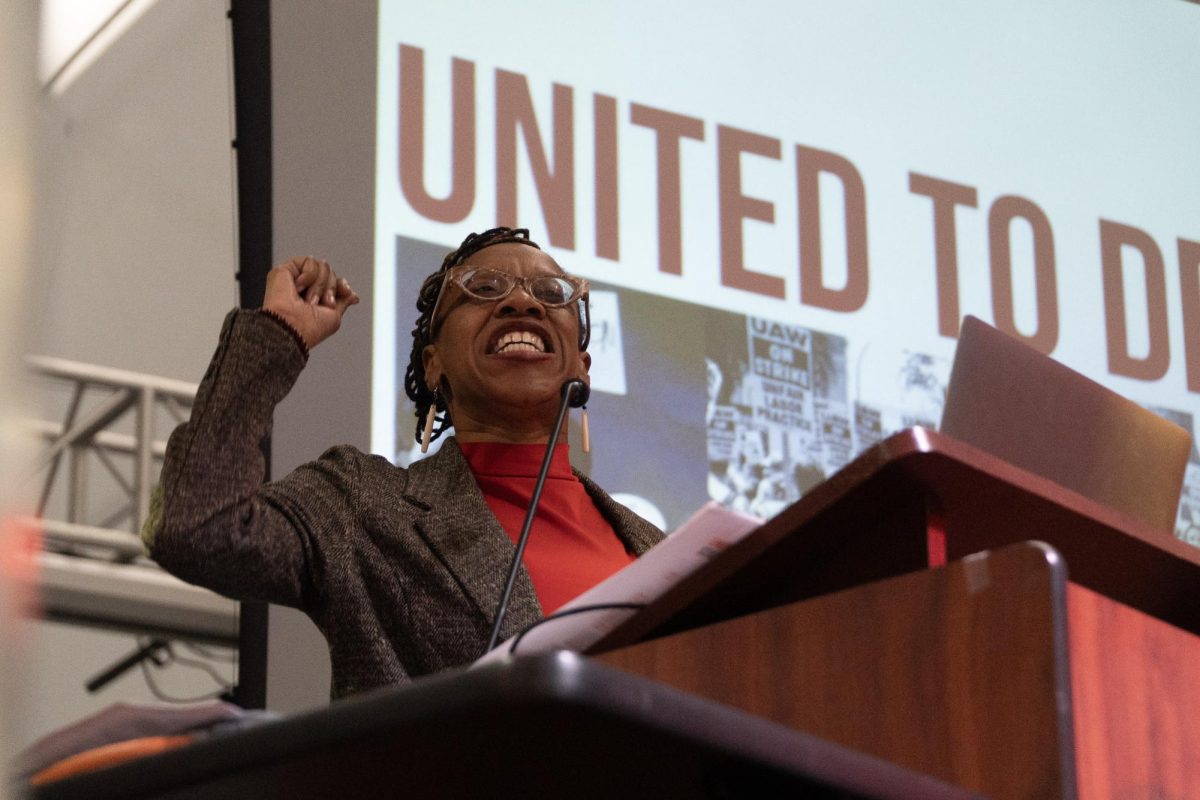Approximately 150 faculty, students and staff from across the California State University system gathered Saturday for a “United to Defend Public Education” conference. The event aimed to organize opposition to budget cuts and what speakers described as the increasing financialization of public higher education.
“We know that after the November elections, we can’t just do things the same anymore,” said Charles Toombs, California Faculty Association president. “How many people came out today is a structure test in organizing. We look at structure tests how if we couldn’t get anything to come out to this, we’re not going to get a big crowd in Sacramento on April 17.”
Organizers announced plans for coordinated actions this spring, including campus actions sometime in March for a Red for Ed week, a “National Day of Action” on April 17 with demonstrations in Sacramento and possibly in Long Beach, and a protest on May 1, International Workers Day.
Margarita Berta-Ávila, the vice president of the CFA, said the conference was organized to fight issues affecting the CSU, including Governor Gavin Newsom’s proposed 7.95% budget cut, lecturer layoffs, high administrator salaries and the implementation of AI in education.

“We had 300 people registered for this conference, but we didn’t have 300 people show up — and you know why? Because many of our colleagues are demoralized,” said Blanca Missé, CFA San Francisco membership chair. “There is this $17 million deficit in this campus that is torturing us, terrorizing us, dividing us, putting the faculty against the staff, the humanities against the sciences.”
A video titled “How a Public University Turned into a Profit Mill,” created by Brian Yan and Sohrab Ford of the San Francisco State University Student Union and SFSU professor James Martel, outlined how the CSU system has accumulated substantial financial reserves while implementing austerity measures.
The video stated that the CSU was created in 1960 under the California Master Plan for Higher Education and didn’t initially charge tuition. In 1976, the system began investing donations in low-risk securities through external accounts. After the system began to charge fees in 1981, fee revenue was added to investments in 1988. In 2006, tuition funds were added. More recently, in 2017, the CSU began investing in high-risk securities.
Bob Meister, a professor at UC Santa Cruz, echoed the video, detailing how both the UC and CSU systems have amassed investments while simultaneously cutting academic programs and decreasing quality. He said that universities have been using their branding and rankings as assets and have made students feel successful simply for attending regardless of what they learn.
“The deal that the university has with us is that it will call us good and give us credit for being good if we’re willing to call it good,” Meister said. “The time has come to say it’s no good.”

Lark Winner, a student from CSU San Bernardino and the president of UAW Local 4123, which represents about 10,000 student workers across CSU campuses, highlighted the lack of sick leave and benefits for instructional student assistants. Winner also spoke about budget cuts at multiple CSUs and recent investments in property instead of people.
“In just a few years, my kids will start becoming ready to pursue higher education… I’m afraid that they will not have the same access that their mother did,” Winner said. “I’m also deeply worried that future non-traditional students like myself won’t have the same opportunities that I have had. With the Trump administration preparing to wage war on public education from K-12 to public universities, the CSU should be leading the charge in defending and expanding access to meaningful higher education for our communities, not creatively cutting programs, cutting the budget by 8% and using the remaining CSU budget to support only management’s priorities.”
Organizers introduced nine organizing platforms:
- Governor Newsom: No State Cuts, Fully Fund the CSU and Public Higher Education
- Chancellor García: Reinvest the People’s Money Back Into the Classroom
- Board of Trustees: Declare Sanctuary Campuses
- Defend the People’s University: Liberate the CSU
- Protect Our Right To Educate and Organize: Defend Academic Freedom and Our Civil Liberties
- Money for Jobs and Education, Not for War, Incarceration, and Deportation
- Tenure for All: Abolish the Two-Tier Faculty Labor System
- Worker Control of AI Education To Prioritize Student Learning and Critical Thinking
- Tax the Rich and Big Corporations, Not Working People
Conference participants organized into working groups to plan the implementation of these initiatives, with a focus on building solidarity between faculty, students and staff.
“The phone calls, they matter; the letters matter, the actions matter,” said U.S. Rep. Lateefah Simon, who represents California’s 12th district and was a CSU trustee. “They matter to the people of conscience who are serving on — not just the Board of Trustees of the California State University — but for every single board you’re going up against.”
Simon thanked attendees for holding trustees and administrators accountable.
“This is about organizing everybody who didn’t show up today,” said Missé, emphasizing the need to expand participation in upcoming actions. “We must create organized networks of support between local unions, student organizations, community members, politicians, alumni and the general public.”

